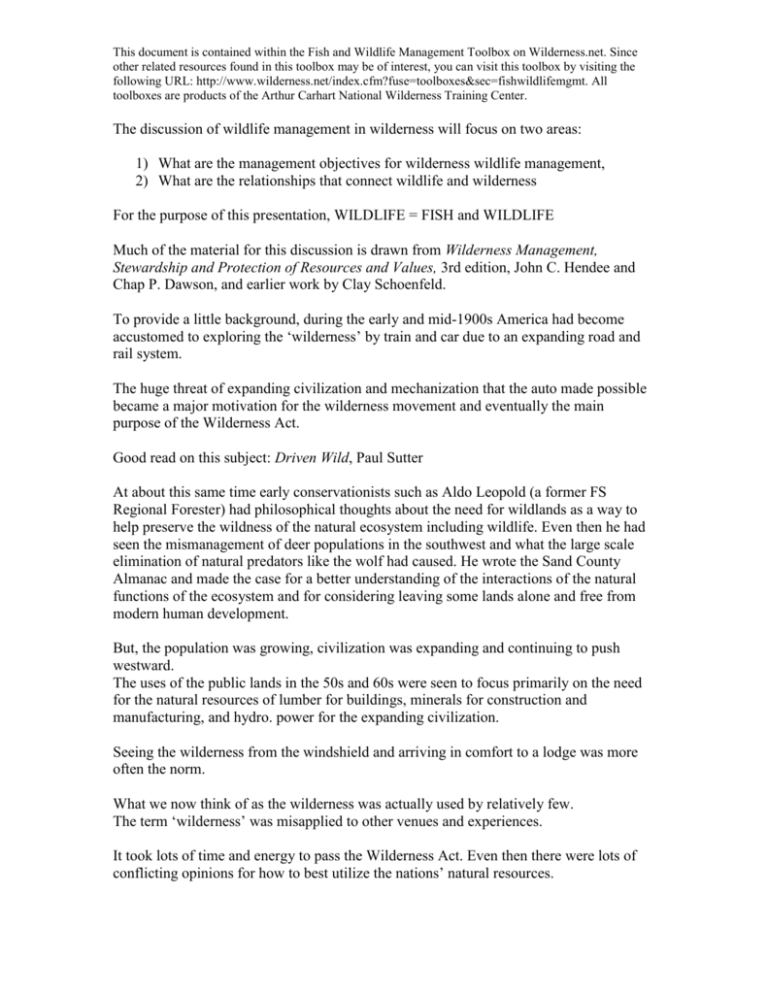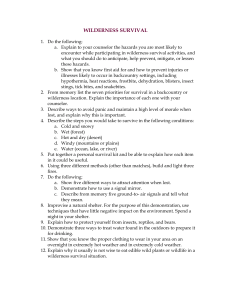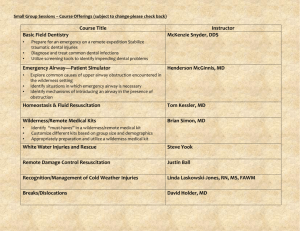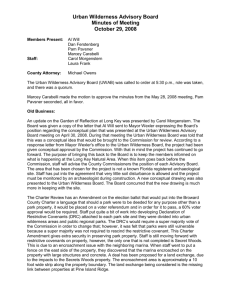The discussion of wildlife management in
advertisement

This document is contained within the Fish and Wildlife Management Toolbox on Wilderness.net. Since other related resources found in this toolbox may be of interest, you can visit this toolbox by visiting the following URL: http://www.wilderness.net/index.cfm?fuse=toolboxes&sec=fishwildlifemgmt. All toolboxes are products of the Arthur Carhart National Wilderness Training Center. The discussion of wildlife management in wilderness will focus on two areas: 1) What are the management objectives for wilderness wildlife management, 2) What are the relationships that connect wildlife and wilderness For the purpose of this presentation, WILDLIFE = FISH and WILDLIFE Much of the material for this discussion is drawn from Wilderness Management, Stewardship and Protection of Resources and Values, 3rd edition, John C. Hendee and Chap P. Dawson, and earlier work by Clay Schoenfeld. To provide a little background, during the early and mid-1900s America had become accustomed to exploring the ‘wilderness’ by train and car due to an expanding road and rail system. The huge threat of expanding civilization and mechanization that the auto made possible became a major motivation for the wilderness movement and eventually the main purpose of the Wilderness Act. Good read on this subject: Driven Wild, Paul Sutter At about this same time early conservationists such as Aldo Leopold (a former FS Regional Forester) had philosophical thoughts about the need for wildlands as a way to help preserve the wildness of the natural ecosystem including wildlife. Even then he had seen the mismanagement of deer populations in the southwest and what the large scale elimination of natural predators like the wolf had caused. He wrote the Sand County Almanac and made the case for a better understanding of the interactions of the natural functions of the ecosystem and for considering leaving some lands alone and free from modern human development. But, the population was growing, civilization was expanding and continuing to push westward. The uses of the public lands in the 50s and 60s were seen to focus primarily on the need for the natural resources of lumber for buildings, minerals for construction and manufacturing, and hydro. power for the expanding civilization. Seeing the wilderness from the windshield and arriving in comfort to a lodge was more often the norm. What we now think of as the wilderness was actually used by relatively few. The term ‘wilderness’ was misapplied to other venues and experiences. It took lots of time and energy to pass the Wilderness Act. Even then there were lots of conflicting opinions for how to best utilize the nations’ natural resources. Looking back at the Congressional Record, we see that some of the debate was about wildlife and wilderness. As is often the case, much of what goes into the congressional debates and the record is generated from the public who share their opinions with their elected representatives. Finally, after a tireless effort by wilderness supporters, and strong bi-partisan agreement, President Johnson signed the Wilderness Act in 1964. The 40th Anniversary of the Act is coming up next year. This was and is no small thing. Lots of compromises were made, out of political necessity, to insure passage. These compromises present the most challenging issues for wilderness stewards today. And, frankly there is much in the Act that is not black and white and is qualified by the language of the Act so that each unique wilderness can be managed as needed depending on the necessity to take management action on a particular issue. When you think about it, this is a brilliant way to set aside lands as wilderness. The politicians compromised just enough with the competing interests but put the long-term stewardship of wilderness in the hands of natural resource professionals such as us. The Wilderness Act established the concept of the ‘wilderness resource’ as opposed to ‘resources’. The resource is a collection of physical and emotional values that help define what wilderness is. Though wilderness provides a number of values that make up the ‘resource’ it is important that we manage it as a whole and not favor any one value in our stewardship. Another way to think about wilderness is in terms of the benefits it provides. These benefits encompass a variety of components including biological habitats and populations, physical settings and social experiences. To begin our discussion lets first look at management objectives for wilderness The first objective is to seek NATURAL distributions, numbers, and interactions of indigenous species. Where does this come from? Why is this important? It comes from Section 2a of the Act and is part of how the ‘Purpose of Wilderness’ is defined. There had to be a documented and described purpose for wilderness to raise the awareness of the importance of wilderness and to rally support to get the law passed. The main concern, even in 1964, was that growing mechanization and civilization would get to the point where there would be nothing natural left. Therefore we have the language of preservation and protection in a natural condition. Obviously this doesn’t mean just the ‘land’ but by protecting the lands managed by federal agencies there would be protection for the ecosystems, including the wildlife, that are dependent on those lands. We’ll see that more in another part of he Act in a slide to come. This objective is derived directly from the law to comply with the definition of what wilderness is. Wilderness is undeveloped land, It retains its primeval character and influence, that is to say without the influences commonly associated with our modern society. The definition includes management direction to us to insure that theses areas are protected to insure that natural conditions exist and natural processes dominate. For wildlife management this translates into recognizing and giving precedence to the forces of nature, whether they benefit of detract from the health of certain wildlife populations. We need to discuss this objective in two parts. First, ‘the earth and its community of life’ defines wilderness as the entire ecosystem contained within the boundaries of designated lands. No one resource (Physical, biological, or social) is singled out. But, the other meaning of this definition centers around the word ‘untrammeled’. Anybody want to guess at what that means? It is a word that the author of the Act, Howard Zahniser chose for specific reasons and defended against congressional challenges. Why not just use a more common word such as untrampled? Because it doesn’t mean the same thing. They recognized that even in ’64 many lands had seen use and impacts by humans and that areas did not need to e completely untouched and pristine to be considered wilderness. The meaning they were trying to convey was that wilderness is a place that is uncontrolled and un-manipulated by humans. The effects of ‘Acts of nature’ in wilderness (such as fire, flood, etc.) are neither good nor bad, they just are a part of the natural processes, uncontrolled by humans. But this also tells us that, as stewards of wilderness, we don’t manipulate or control what happened in wilderness to either degrade or improve the natural conditions. Recognizing that al is not black and white the Act allows for some intrusions by using the qualifier ‘substantially’ unnoticeable. This doesn’t mean it’s OK to ‘trammel’ the wilderness as long as nobody sees it. The second part of this objective is relates directly to what managers can and cannot do in wilderness. If we are going to not control or manipulate or insure that the imprint of man’s works are substantially unnoticeable then we nee to operate within a set of guidelines. The items listed here are the things that wilderness managers are generally prohibited from doing. Again, not all is black and white so the generally prohibited items listed here are qualified by the phrase ‘except as necessary to meet the minimum requirements for the admin. of the area for the purpose of the Act. This definition refers to administrative activities. The public is never allowed to do any of this. We’ll talk more specifically about what this means a little later in a discussion of wilderness character. For now, the point is to recognize that our actions as wilderness and wildlife managers does contribute to keeping wilderness untrammeled and to preserving natural conditions. The objective is supported by four different portions of the Act. Clearly one of the purposes of wilderness is for ‘the use and enjoyment’ of those who visit, view it from a distance, or just know that it’s there. But to remind us that wilderness is a permanent investment of the public lands the Act sets direction to constrain our management within the wilderness context. To carry this premise of public use of wilderness further, the definition of wilderness describes wilderness as a place where solitude or primitive recreation opportunities can be found. “Primitive recreation’ is one of the key terms that has allowed the wilderness management agencies to define what types of recreation and what types of recreational equipment are appropriate in wilderness ands ‘solitude’ is one of the constraints that we consider before approving exceptions to the generally prohibited administrative activities. Another part of the Act that support this objective comes from the Use of Wilderness section which further describes the purpose of wilderness by recognizing that the public purposes of wilderness (recreational, scenic, scientific, educational, conservation, and historic use) are what wilderness is for ‘except as otherwise described in the Act’. This means that recreation, scientific study, whatever, are appropriate as long as they don’t impair the natural conditions, natural processes (forces of nature dominate) and wilderness character. Finally, as one of the Special Provisions, and a key point in gaining support for passage of the Act, you as state wildlife managers still have jurisdiction over management of fish and wildlife species. As we will hear about during the discussion of the IAFWA agreement and elsewhere this is to be done within the constraints of the Act and in a cooperative manner. This part of the definition of wilderness has been discussed previously in regards to allowing natural processes to influence wildlife populations. In support of this objective it is also relevant. If a species is wilderness dependent and native then it is part of the natural condition. If human influences are impairing the survival of those species in wilderness than managers should prescribe measures to reduce or eliminate the impairment. In the Use of Wilderness section we see that although wilderness is a unique part of federal lands the purpose of wilderness are ‘within and supplemental’ to the other purposes of the national forest. Certainly one of the key purposes in creating and managing the national forests is for wildlife habitat and also recreation activities associated with wildlife. The phrase ‘within and supplemental’ is an important element of wilderness management. Wilderness is not in conflict with the multiple use mission of the FS and is not in conflict with the Multiple Use Sustained Yield Act of 1960 or other legislation pertaining to management of the national forests. Section 4a of the Wilderness At reference other laws and makes clear that wilderness is not in conflict. But what about subsequent laws? The most often cited potential for conflict is with the Endangered Species Act. At times there is a notion that a law such as ESA ‘trumps’ the Wilderness Act. The wilderness Act tells us not to ‘trammel’ the wilderness. We cannot control or manipulate the natural conditions. The ESA tells us that we can’t jeopardize the existence of a species, including those that are wilderness dependent. The ESA does not trump the Wilderness Act. We need to meet the intent of both laws and find a way to help conserve listed species without compromising wilderness purposes or objectives. What do we do? We concentrate on insuring that unnatural, human caused influences on wilderness are not causing loss of critical habitat for wilderness dependent species. This could include impacts from visitor use, introduction of non-native invasive species, total suppression of fires, etc. It would not include artificial improvement of natural conditions that are not being degraded by human influences. This objective recognizes that the Wilderness Act and other applicable legislation (ESA, Heritage Resource Protection Act, Dam Safety Act, etc.) must be satisfied but that the goal is to limit any possible degradation of ‘wilderness character’. A degradation of wilderness character would not meet the purpose or definition of wilderness such as the protection of natural conditions. But, what is meant by ‘degradation of wilderness character’ ? Certainly part of how we avoid this is by insuring that we don’t trammel – control or manipulate the ecosystem. Also we can insure that the character is not impaired by limiting the use of the generally prohibited administrative uses (Motorized equipment, mechanical transport, landing of aircraft, structures, etc.) But, it may still be difficult to define exactly what is meant by ‘wilderness character’. It must be important because they told us to do it twice in one sentence and, it’s a ‘shall’ not a ‘may’. There are very few ‘shalls’ in the Act and we know from the congressional record that the language of laws is very important and not taken lightly in congress or subsequent legal interpretations. Wilderness character is preserved by not impairing or degrading the qualities that define what wilderness character is. We accomplish this by insuring that as we steward wilderness to meet the objectives of various laws and insure the purposes for which wilderness was created are achieved by cooperatively managing wilderness wildlife using every effort to avoid or limit actions that might cause a degradation or impairment. Now lets focus the discussion of wildlife management in wilderness on the second topic. 1) What are the management objectives for wilderness wildlife management 2) What are the relationships that connect wildlife and wilderness Just what do we mean by the term ‘Wilderness Wildlife Relationships’? Is there something unique and special about wildlife in wilderness that should be considered by wildlife and wilderness managers? It seems that wilderness and wildlife are somewhat co-dependent and that the survival of each depends on the other. Let’s look at what these relationships might be. When we talk about preserving wilderness character we include wildlife as part of what makes up wilderness character. How well native populations are doing in response to both natural and human caused influences is an indicator of how well wilderness character is being preserved in terms of naturalness, and the human experiences related to wilderness. Wildlife is inseparable from wilderness. It’s hard to think of wilderness without thinking of it in terms of habitat and the fish and wildl.ife species that live there. More specifically, wildlife contribute in a variety of ways to the functioning of the natural processes which sustain the community of life that provide the natural conditions that wilderness is all about. Many wildlife species are wilderness dependent or associated and would not be around or would not be thriving without the habitat that wilderness provides. One of the public purposes of wilderness is scientific use. Certainly it is appropriate for wilderness to serve as that laboratory. It may be an important source of genetic material. It may offer standards for comparing undisturbed lands with more heavily developed areas. And, it may offer the best opportunity to discover, and monitor ecosystem function. But, as we discussed a little earlier and will again later today, the scientific use of wilderness must be within the context of wilderness and conducted if necessary and with the use of the minimum tool and method necessary to limit human caused impairment. Finally, wilderness wildlife has an influence on us as and how we live, recreate, earn a living, vote, etc. Some of this influence is obvious to those of us who work in natural resource management such as the economics of outfitter guides and other businesses that serve hunters, fishermen, and other wilderness visitors but it also cuts across political party affiliations and rural-urban demographics. Several recent surveys conducted by the FS and others have shown that a majority of Americans of all backgrounds and persuasions favor the protection of wildlands even if they never have and maybe never will visit them. The wilderness wildlife relationship is co-dependent for the reasons described in the previous slides.





